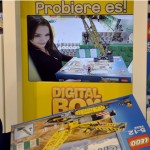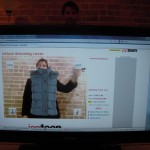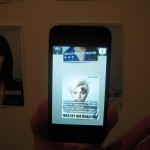[Article by Bart S. Alvara]
On Thursday March 27th, a bold new vision of the future was being unveiled at the staff offices at Metaio. While music played and drinks were shared visitors to the San Francisco outlet of the independent company were captivated by a new visual recognition software that may change how we view reality.
Augmented Reality combines the real and the visual world in real time 3D placing the viewer in the center of an interactive digital world. In non tech-genius speak, a camera is programmed to look only for a certain image, when this image is recognized, a stored illustration is activated and the display reflects that overlapping illustration on screen. Or as the staff at Metaio can state better, “we connect any object to additional, digital information. Our vision is the seamless and easy integration of the virtual into the real world.” Essentially it’s a private green screen, like a movie special effects studio, that can be run from an something as small as a cell phone.
While that might be hard to understand, the applications are not. Imagine if your cell phone could simply look at a product and suddenly on screen all the information relating to it popped. Or your cell phone could display whose trending on twitter or Facebook in your immediate area. This digital interactive advertising was once thought up only in sci-fi movies, yet with the technology provided by Metaio, it may become the standard for the 21st century.
You can contact Bart S. Alvara at bartalvara@gmail.com. Click here for Metaio’s Website.
At the party where the San Francisco team of Metaio had interactive kiosks to display the technology I had a chance to use the program first hand. Some were simple games, a surfing app where I just held a shoe up and moved the digitally displayed character until I realized that my surfing skills were just as bad virtually as there are in real life. At a display of Lego products, I felt the eight-year-old glee of playing with Lego’s again, yet this time, the on-screen display showed the finished product as I held it. In one of the most visceral and effective advertising displays I have seen, I watched a picture of a beautiful woman suddenly come alive. Yet it was assaulted and the woman returned, bruised and battered, while a message to end domestic violence appeared. The spirit behind that ad was to show that, “female victims mostly live in two parallel worlds: while the print campaign suggests a perfect world, the augmented reality leads us into the terrible abyss of the women’s fate.” According the Metaio marketing team, “the campaign is a fine example how augmented reality in combination with the right idea can make a valuable contribution to the social sector.”
While the team in San Francisco is a new start-up, they have years of research and a cutting edge technology ready to wield. “According to Gartner Inc., Augmented Reality is one of the Top 10 strategic IT technologies of our time,” the staff reminds. “Juniper Research forecasts $1.5 billion revenue stream by 2015,” very notable considering the technology developed only ten years ago with a simple brainstorm from an autoworker. Currently the product is utilized by over 450 customers, internationally, that serve over 3 million clients.
Opportunities for the software have already found their way into different applications. Lego has found the perfect use for the technology by displaying the finished product on screen. Seventeen magazine has the program setup on its website so clothes can be tried on via the web. It has the outfit projected on screen with adjustable sizes that conform to the person’s digital image. Other major companies have movies pop up to project a digital world were the viewer is part of the show.
Yet prospects for future uses are wide and still untapped. Architects could design a building in an interactive digital world so their clients could have a virtual tour of their finished product before starting their project. Or what if museums could map out an exhibit redesign in relative ease before having to paint a single wall? General Contractors could show home owners what their new backyard or bathroom would be like before the first nail is hammered. It could easily become a new medium of art, where the artist creates a visual experience, within a digital world.
San Francisco is the only place in the country that Metaio chose to start the American marketing of the digital software. While the Metaio’s software was originally designed in Europe it is in San Francisco that they hope to expand its use and to open it to new markets. According to Tia Jackson at Metaio, “San Francisco has an abundance of creative, advertising and branding agencies that make this the ideal place to combine our innovative cutting edge technology with some of the most creative agencies in the world.”
For further information about augmented reality or Metaio you can find them at; www.metaio.com or email Tia Jackson at tia.jackson@metaio.com or follow them on Twitter @metaious.



